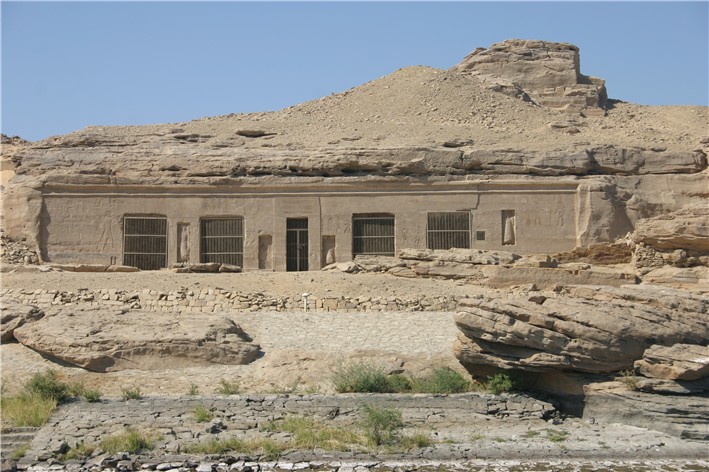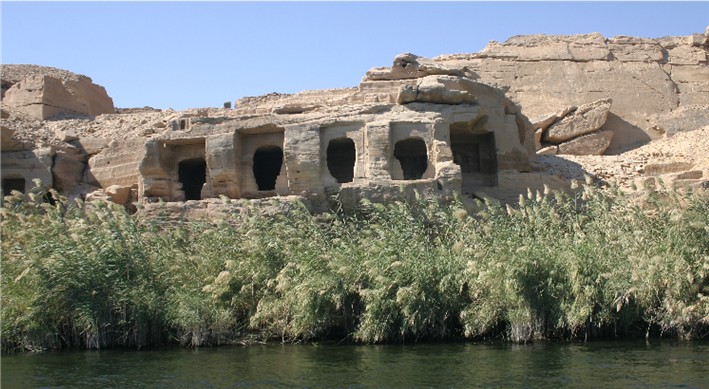|
Maat-ka-Ra Hatshepsut |
last update:
16.10.2008
|
|
Gebel es-Silsilah
|
|
| GPS-Coordinates |
|
|
| |
Latitude: |
24° 38' 46.84 N |
| |
Longitude: |
32° 55' 46.31 E |
| Boating the Nile upstream, approx. 150 kms to the south of
Luxor one passes the rock monuments of Gebel es-Silsilah. The modern arabic name
Gebel es-Silsilah means "the mountain of the chain" and tells of chain that was
fastened across the Nile to hinder navigation. The pharaonic name was
$nw, $nj (= place to row). |
| From the Middle Kingdom
to Roman times sandstones were continuously quarried on both sides of the river
and used for the pharaonic constructions. To the greater extent the quarrying of
sandstone obviously began in the reign of Hatshepsut. The work in the quarry
presumably began in the area 3 at Silsilah-West where , e.g.,
the stones for the temples of Satet and Chnum built by Hatshepsut on the island of Elephantine had
been obtained. |
| The southern border of the area 3 is marked by a loading
platform for stones, to the north the area continuous with totally 32 historic
architectural monuments whose row is closed in the north after approx. 195 ms by
the Speos of Haremhab (see below). |

|
Speos of Haremhab at Gebel es-Silsilah (photo by E. Noppes) |
| The following table gives an overview about the builders of the
chapels, provided that these can be identified up to now. Strikingly often
officials from the beginning of the 18th Dynasty are represented, particularly
from the reign of Hatshepsut and Thutmosis III. |
| Shrine No. |
Name /
Transliteration |
Date |
Distance to the Speos of Haremhab
[~ m] |
Remarks |
| 1 | | |
195 |
uninscribed |
| 2 | | |
199 |
uninscribed |
| 3 | | |
228 |
uninscribed |
| 4 |
prob. a Djehutjmose |
End
of 18th Dynasty or shortly after |
231 |
|
|
5 |
Min (Menu) |
Thutmosis III |
237 |
|
|
6 |
Ahmose, JaH-msw |
joined reign of Hatshepsut and Thutmosis III |
249 |
|
|
7 | |
joined reign of Hatshepsut and Thutmosis III |
255 |
|
| 8 | | |
280 |
uninscribed |
| 9 | | |
292 |
uninscribed |
| 10 | | |
304 |
uninscribed |
|
11 |
Senynefer, Hatshepsut,
and others |
Amenophis II |
337 |
|
|
12 |
Min-nakhte |
Thutmosis III |
364 |
|
|
13 |
Senneferi |
joined reign of Hatshepsut and Thutmosis III |
367 |
|
|
14 |
Nehesj NHsj |
joined reign of Hatshepsut and Thutmosis III |
370 |
|
|
15 |
Hapuseneb
¡pw-snb |
Hatshepsut |
373 |
|
|
16 |
Senenmut
%n-n-mwt |
Hatshepsut |
376 |
|
|
17 |
User-amun Wsr-Jmn |
Thutmosis III |
379 |
|
| 18 | |
Amenhotep
II |
387 |
|
| 19 | | |
394 |
uninscribed |
| 20 | |
probably Thutmosis I |
418 |
uninscribed |
| 21 |
Menkh |
Thutmosis I |
422 |
|
| 22 | |
joined reign of Hatshepsut and Thutmosis III |
428 |
|
| 23 |
Min-nakhte |
joined reign of Hatshepsut and Thutmosis III |
429 |
|
| 24 | | |
494 |
uninscribed |
| 25 |
Amenemhat |
prob. Amenhotep II or Thutmosis IV |
541 |
|
| 26 |
a
viceroy of Cush (Merimose?) |
Amenhotep
III |
567 |
|
| 27 | | |
577 |
|
| 28 | | |
588 |
uninscribed |
| 29 | | |
600 |
|
| 30 | |
joined reign of Hatshepsut and Thutmosis III |
664 |
|
| 31 |
Neferkhewe |
Thutmosis III |
669 |
|
| 32 | | |
680 |
uninscribed, ruined |
| All data according to Caminos, 1963 |
| These historic monuments were called sometimes grottos, graves,
cenotaphs, shrines, chapels or rock temples. The different terms reflect the
uncertainty upon which purpose they could have served. This uncertainty was also
not solved by the discovery that most of the owners had a complete tomb at
Thebes west. Based on the wall inscriptions the latest interpretation (Bommas)
recognizes in these constructions offering chapels. |
| The chapels have been built on a east-west axis, i.e. the
entrance to the chapels lies on the eastern side directed to the Nile. In the
most cases the chapels only one room was cut into the rock. |
| The lintel usually shows the name of the king during whose reign
the owner carried out his duties and whose favor(s) made it possible for the
owner to build the chapel. Above that a winged sun-disk (BHdtj) is depicted. The
door-jambs shows offering formulas. In many chapels the walls show banquet
scenes, offerings for the deceased, lists of offerings, and cleansing rites. |
| On the rear wall, the west-wall of the chapels, frequently
seated statues of the owner - with or without relatives - had been cut out of the
rock. Similar seated statues can be found in the tombs of the Theban necropolis.
Without exception the owners had been high-ranking officials of this era. |
| On the other hand, there is no false-door in any of the
chapels, which is a clear hint, that a burial of the owner has been never
intended.
|
| The fact that the chapels had been built so near to the river
must be of central importance regarding their interpretation. The chapels had
been built at the level of the yearly flood which happened from May to the end
of August /
beginning of September. However, this can not be observed anymore after the dam
had been built at Aswan. Today, the chapels are 4 to 5 ms above the water
level. Nevertheless, traces of erosion as well as photos from
the beginning of the 20th century show that the chapels No. 12 to
17 had been flooded. |
Only the chapels No. 1, 2 and 11 had been built markedly above
the high(est) water level that was reach during the Nile flood, while the chapel
No. 19 had been been built markedly below this level. Chapels No. 30 to 32 were
built next to the low water level so that they were flooded early with the
ascending flood and eventually became totally flooded.
It is no accident that at least the floor of about 80% of the chapels were
flooded during the high tide of the Nile.
|

| Situation today in comparison to the water level mid of
November - today the entrances of the most chapels are located some ms above the
water level of the Nile so that the chapels can not be entered directly (photo
by E. Noppes). |
| Thus, Bommas points to the regeneration of the
country in connection with the cyclically returning Nile-flood. Only the
cyclically returning flooding of the fields by the Nile ensures the (new) life.
On the other side, a guaranteed material supply in the afterlife is one of the
most important desires of the deceased. Hence, the Nile should not only flood
the earthly fields, but also find the way to the dead (his tomb) and flood his
fields in the hereafter.
|
The desire of the dead for the presence of the Nile resp. the
flooding of his tomb is testified several times, e.g. in the spell No. 169 (lines 118 u. 119)
of the "Book of the Dead" (Hornung, 1998):
"...
The flood (Hapi) undulates above your chest,
and this is more useful than what is carved on the stela. ...". |
| Due to this passage in the Book of Dead the Nile flood is more
important than a prayer carved in stone - since a prayer must be articulated to
be effective. However, most of the ancient necropoles are - with good reasons -
located outside the flood area. Therefore, there was not too much hope that the
Nile would reach the tombs. |
| The course of the Nile at Gebel es-Silsilah is determined by a
geologic specific feature. In contrast to other places in Egypt here the
riverbed becomes narrowed by sandstone rocks rising directly at the river banks.
Before the construction of the dam the flood was blocked by the natural
narrowing and did not only rose higher but also reached chronologically earlier
higher levels as somewhere else. Here the Nile flood manifested itself more
impressive than somewhere else. |
| According to Bommas it is this effect that is of essential
importance for the ritual understanding of the chapels at Gebel es-Silsilah.
According to his view this imposing high Nile flood was interpreted as an
expression of the primeval water, in most cases - as shown by several
inscriptions in the chapels - worshipped as the god Nun. |
| Hence, here in Gebel es-Silsilah the desire for the "supply" in
the afterworld by the Nile flood could be "realized" because it was possible to
build the chapels not only directly on the banks of the river but also in the
flood area. This would also explain the similarities of the architecture and the
decoration of the chapels in comparison with the tomb chapels in Thebes which
was presumably chosen deliberately to keep the differences to the chapels in the
necropolis as low as possible. Furthermore, any risk of the destructive power of
the water on the afterlife was banished here, far away from the real tomb. No
other place in ancient Egypt was more suitable to fulfill the desire of the
deceased for cyclic regeneration.
|
| (Purification and) regeneration of the deceased were
guaranteed, actually, in ritual actions. Whether in Gebel es-Silsilah really a
lasting cult for the deceased was carried out by the surviving relatives, cannot
be proved. However, in the opinion of Bommas this is also irrelevant because
(purification and) regeneration are kept ongoing by the annual Nile flood
itself. |
|
In the view of Bommas the chapels built in the flood area of Gebel es-Silsilah
are the petrified desire of their builders for regenerative supply in the
afterlife by the returning flood by the Nile. Furthermore, the cyclic return of
the Nile flood makes the supply in the afterlife independent of the
imponderabilities of a cult for the deceased which should be carried out by the
dependents.
|
|

